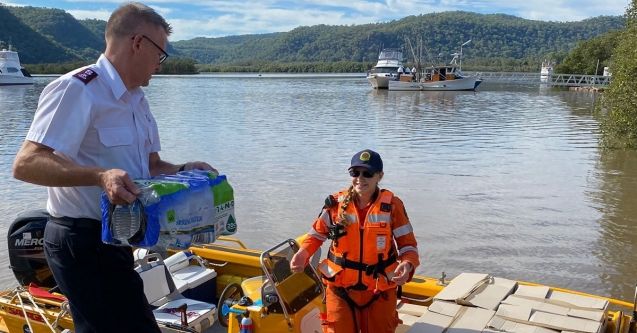Disaster mode kicks in again under different skies
26 March 2021

Just over 12 months ago, the skies over much of New South Wales were filled with smoke as bushfires raged and temperatures soared. Fast forward to March 2021 and the skies have taken on a different look, with a week of torrential rain resulting in devastating floods across much of the state.
It’s been with a sense of sombre familiarity that Salvation Army Emergency Services (SAES) teams have once-again swung into action to serve communities in crisis. Many of the state’s major river systems along the eastern seaboard have burst their banks, with the worst of the flooding hitting the Mid-North Coast and outlying areas of western Sydney.
SAES teams continue to provide support at numerous evacuation centres across the state, with more than 3000 meals served since 19 March.
At the frontline
When SAES volunteer Terry Capon answered the call to serve in north-west Sydney, he found himself on the opposite side of the Hawkesbury River to his home and family. One of the dozens of dedicated SAES personnel and volunteers who have dropped everything to serve at evacuations centres across the state, Terry is serving evacuees at the Meroo Christian Camp. His team has also been transporting meals to another evacuation centre nearby.
Despite being cut off by floodwaters, Terry has focussed his energy on heading up the Salvo emergency catering team with rapidly diminishing food supplies. Isolated and with supermarket shelves emptied, the team have faced challenges they haven’t faced in previous disasters. “The supermarkets look like they did at the height of the COVID clearance, but unlike when they were in COVID, the supermarkets can’t restock,” he says.
Terry has had years of experience serving at the frontline in floods and fires, at evacuation centres, remote fire-staging grounds and, at the Rural Fire Service base camp during the 2019-20 bushfire disaster where SAES teams served hundreds of meals a day.
“This is a bit different,” Terry says. “We are isolated and we can’t get people to take over if we get fatigued. But at the moment I’m still in a good mood!
“We have just had a mercy shipment ferried across the river from the Sydney side [by the State Emergency Service] so we can cook meals for the next three days,” he says. “For the moment I’m stuck on this side of the river away from home until the river goes down ... and we are not sure how long that is going to be. [But] I like to help where I can.”
Homes inundated
In the space of 24 hours at the weekend, the Mid-North Coast town of Taree was cut off by floodwaters, as homes and businesses became inundated.
“The floods came up really suddenly overnight on Friday night,” says Salvation Army Corps Officer for Taree, Major Sandy Hogg. “On Saturday morning we woke up to people being evacuated and having to leave houses that were already flooded.”
It’s been more than 12 months of “one disaster after another” for so many NSW communities impacted by the 2019-20 bushfires, COVID-19 and now devastating floods. “We just stepped straight back into it,” says Sandy of her dedicated SAES team. “[After the bushfires] we just knew what to do.”
Her team was one of dozens from across the state who turned up at evacuation centres to serve the thousands of people forced to leave their homes as the extreme wet-weather system pummelled the state. “We have an absolutely wonderful bunch of volunteers and everyone has pulled together so well,” says Sandy.
And while floodwaters peaked over the weekend in Taree, and those who can have now returned home, Sandy knows that the recovery – like that of the bushfires – will be ongoing for a long time. She’s worried about how people are going to cope when resilience levels were already so low.
“Everybody’s just had enough of it,” she said. “We all just kind of think: ‘What’s next?’ I sense a lot of frustration and a lot of fear. It’s very sad and a very disheartening time.”
The Salvation Army will continue to respond to the needs of these affected communities during the emergency and for the long-term.
The Australian Government is now providing cash grants of $1000 per adult and $400 per child to eligible people affected by the NSW storm and floods. Learn more and to see if you are eligible below.
This article first appeared in The Salvation Army’s online magazine Others.org.au